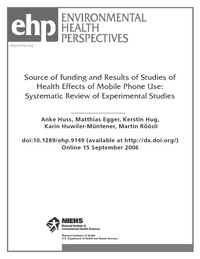Source of Funding and Results of Studies of Health Effects of Mobile Phone UseSystematic Review of Experimental Studies
|
 |
 Diese Seite wurde seit 2 Jahren inhaltlich nicht mehr aktualisiert.
Unter Umständen ist sie nicht mehr aktuell.
Diese Seite wurde seit 2 Jahren inhaltlich nicht mehr aktualisiert.
Unter Umständen ist sie nicht mehr aktuell.
 Zusammenfassungen
Zusammenfassungen
Objectives: There is concern regarding the possible health effects of cellular phone
use. We examined whether the source of funding of studies of the effects of low-level
radiofrequency radiation is associated with the results of studies. We conducted a
systematic review of studies of controlled exposure to radiofrequency radiation with
health related outcomes (electroencephalogram, cognitive or cardiovascular function,
hormone levels, symptoms and subjective wellbeing).
Data sources: We searched Embase, Medline and a specialist database in February 2005 and scrutinised reference lists from relevant publications.
Data extraction: Data on the source of funding, study design, methodological quality and other study characteristics were extracted. The primary outcome was the reporting of at least one statistically significant association between the exposure and a health related outcome. Data were analysed using logistic regression models.
Data synthesis: Of 59 studies, 12 (20%) were exclusively funded by the telecommunications industry, 11 (19%) were funded by public agencies or charities, 14 (24%) had mixed funding (including industry) and in 22 (37%) the source of funding was not reported. Studies exclusively funded by industry reported the largest number of outcomes but were least likely to report a statistically significant result: the odds ratio was 0.11 (95% confidence interval 0.02 to 0.78), compared to studies funded by public agencies or charities. This finding was not materially altered in analyses adjusted for the number of outcomes reported, study quality and other factors.
Conclusions: The interpretation of results from studies of health effects of radiofrequency radiation should take sponsorship into account.
Von Anke Huss, Matthias Egger, Kerstin Hug, Karin Huwiler-Müntener, Martin Röösli im Text Source of Funding and Results of Studies of Health Effects of Mobile Phone Use Data sources: We searched Embase, Medline and a specialist database in February 2005 and scrutinised reference lists from relevant publications.
Data extraction: Data on the source of funding, study design, methodological quality and other study characteristics were extracted. The primary outcome was the reporting of at least one statistically significant association between the exposure and a health related outcome. Data were analysed using logistic regression models.
Data synthesis: Of 59 studies, 12 (20%) were exclusively funded by the telecommunications industry, 11 (19%) were funded by public agencies or charities, 14 (24%) had mixed funding (including industry) and in 22 (37%) the source of funding was not reported. Studies exclusively funded by industry reported the largest number of outcomes but were least likely to report a statistically significant result: the odds ratio was 0.11 (95% confidence interval 0.02 to 0.78), compared to studies funded by public agencies or charities. This finding was not materially altered in analyses adjusted for the number of outcomes reported, study quality and other factors.
Conclusions: The interpretation of results from studies of health effects of radiofrequency radiation should take sponsorship into account.
 Bemerkungen
Bemerkungen
 Leider ist die ursprünglich im Biblionetz erfasste URL eines Volltextes seit mehr als sechs Monaten nicht mehr gültig (Fehlermeldung 404) und wurde deshalb gelöscht. Es ist mir nicht bekannt, ob das Dokument unter einer anderen Adresse noch frei auf dem Internet verfügbar ist.
Leider ist die ursprünglich im Biblionetz erfasste URL eines Volltextes seit mehr als sechs Monaten nicht mehr gültig (Fehlermeldung 404) und wurde deshalb gelöscht. Es ist mir nicht bekannt, ob das Dokument unter einer anderen Adresse noch frei auf dem Internet verfügbar ist. Dieser Text erwähnt ...
Dieser Text erwähnt ...
 Begriffe KB IB clear |  Elektrosmog
, Elektrosmog
,  Melatonin
, Melatonin
,  Mobiltelefon Mobiltelefon mobile phone
, Objektivitätobjectivity
, mobile phone
, Objektivitätobjectivity
,  Wissenschaft Wissenschaft science science
|
 Anderswo finden
Anderswo finden
 Volltext dieses Dokuments
Volltext dieses Dokuments
 | Source of Funding and Results of Studies of Health Effects of Mobile Phone Use: Artikel als Volltext ( : :  , 474 kByte) , 474 kByte) |
 Anderswo suchen
Anderswo suchen 
 Beat und dieser Text
Beat und dieser Text
Beat hat Dieser Text während seiner Zeit am Institut für Medien und Schule (IMS) ins Biblionetz aufgenommen. Beat besitzt kein physisches, aber ein digitales Exemplar. (das er aber aus Urheberrechtsgründen nicht einfach weitergeben darf). Aufgrund der wenigen Einträge im Biblionetz scheint er es nicht wirklich gelesen zu haben. Es gibt bisher auch nur wenige Objekte im Biblionetz, die dieses Werk zitieren.











 Biblionetz-History
Biblionetz-History